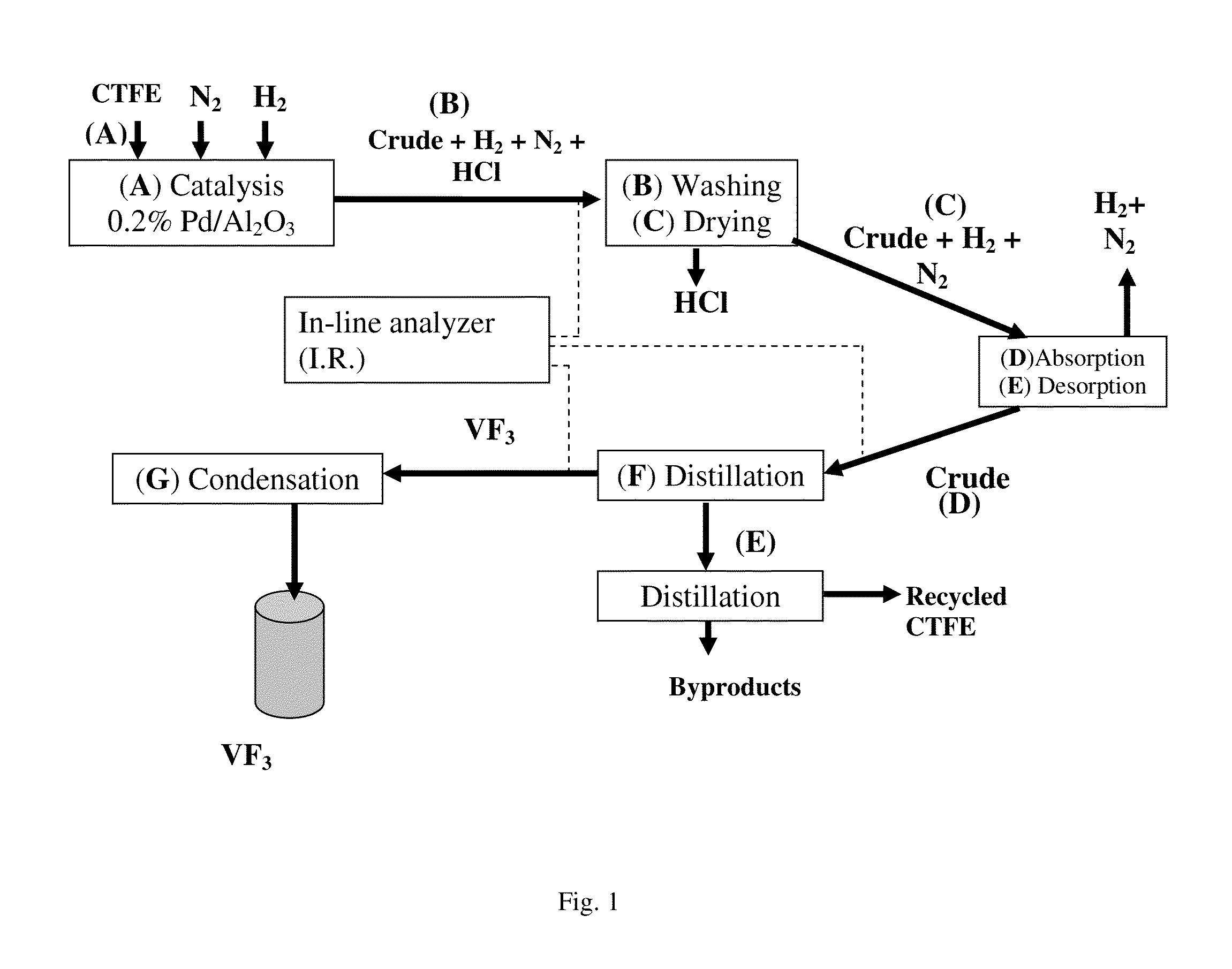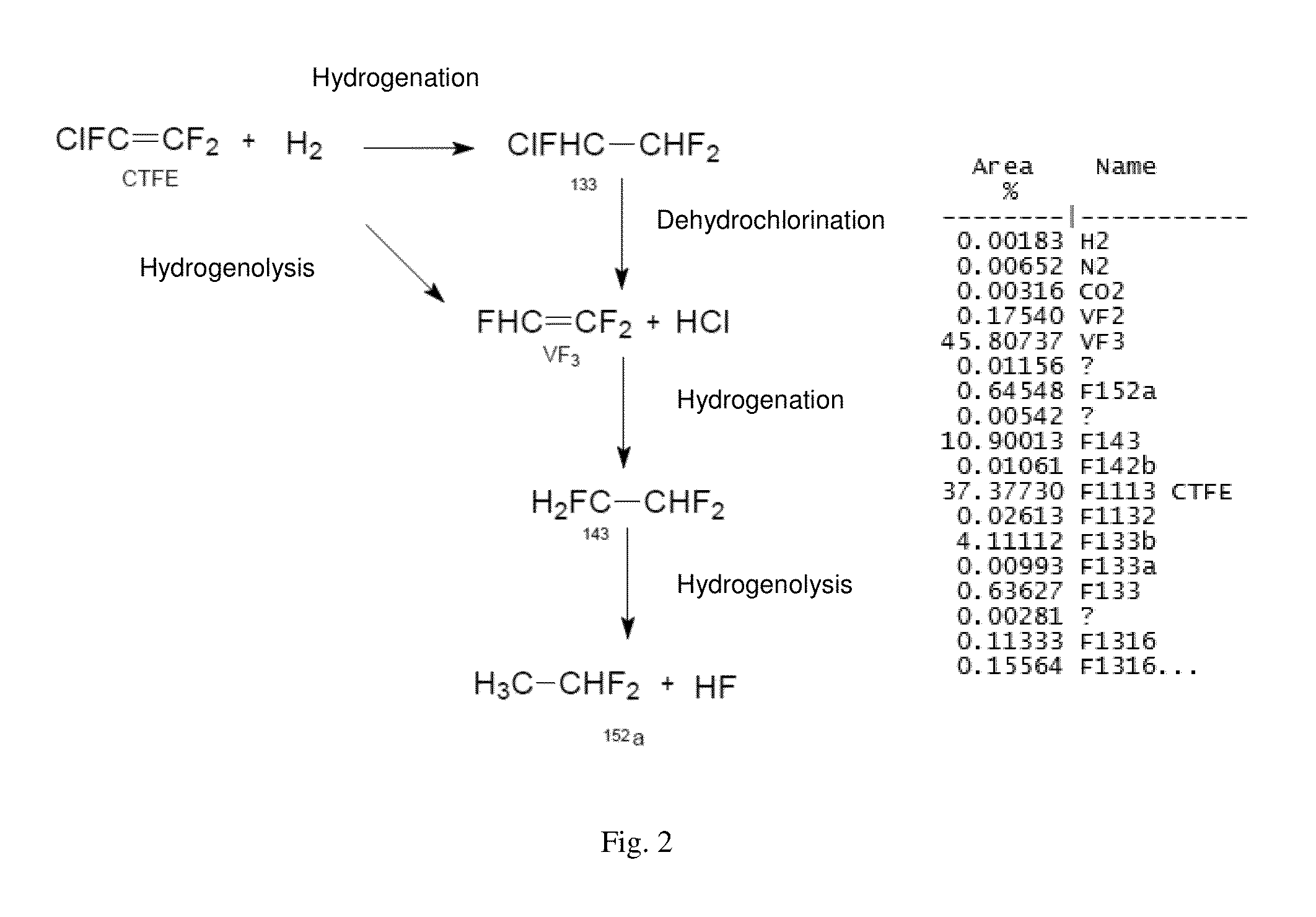Method for synthesising trifluoroethylene from chlorotrifluoroethylene
- Summary
- Abstract
- Description
- Claims
- Application Information
AI Technical Summary
Benefits of technology
Problems solved by technology
Method used
Image
Examples
example 1
Test of the Performances of the Catalysts
Preparation of the Catalytic Charge
[0050]The bed of catalyst to be tested is inserted between two layers of inert substances, such as corindon or silica. In order, a first layer of corindon is introduced, over a height of 50 cm, into a tubular reactor consisting of a stainless steel tube with a length of 1200 mm over a diameter of 25 mm equipped with a jacket. A layer representing 100 cm3 of test catalyst is subsequently introduced onto this layer and then corindon is again introduced above the layer of catalyst until the reaction tube is completely filled.
[0051]The catalyst thus charged is subsequently activated under a stream of hydrogen in the following way: the reaction tube is placed in a tubular furnace and is fed via the top with a stream of hydrogen of 2 mol / h. The furnace is then heated up to 400° C. and the system is left under the same stream of hydrogen for 12 h. After this period of activation at 400° C. (chemical reduction of th...
example 2
Implementation of the Process According to the Invention
[0060]The micropilot plant represented diagrammatically in FIG. 1 was operated in the following way:[0061]4 hydrogenolysis reactors (A), each composed of a metal tube made of stainless steel with a length of 1200 mm and with a diameter of 25 mm, equipped with a jacket over the entire length of the tube, are charged with the following mixture:[0062]66 ml (110 g) of corindon;[0063]275 ml (436 g) of 0.2% Pd / Al2O3 catalyst (BET specific surface=5.3 m2 / g and a pore volume 3 / g);[0064]45 ml (78 g) of corindon.[0065]the catalytic composition is reduced at 250° C. for 6 hours by a flow rate of 1 mol / h of hydrogen.[0066]the jacket of each reactor is subsequently fed with a heat-exchange fluid thermostatically controlled at 25° C.[0067]each reactor is fed with 1 mol / h of CTFE and 1 mol / h of hydrogen. It is also possible to feed the reactors with an inert gas (in this case nitrogen).
[0068]The contact time, calculated as being the ratio of ...
example 3
Preparation of a VF2 / VF3 Copolymer
[0082]396 g of VF3 and 750 g of VF2 are charged to a reactor containing 1862 g of demineralized water, 0.34 g of methylhydroxypropylcellulose and 1.8 g of dipropyl peroxydicarbonate. The reactor is then brought to the temperature of 44° C. The reaction starts and is reflected by a fall in the pressure of the reactor which is compensated for by continuous injection of water. When 700 g of water have been introduced, the injection of water is halted and the pressure falls down to 65 bar. The reactor is then heated to 65° C. and the pressure continues to fall. When the pressure reaches 38 bar, the reactor is cooled down and is then emptied. The reaction mixture collected is filtered and the cake obtained is washed 5 times in 3 l of clean water before being dried in an oven at 70° C. to constant weight. The composition of the resin, analyzed by 1H NMR, is found to be equal to 31.2 mol % of VF3. The thermal characterization by DSC reveals a ferroelectric...
PUM
| Property | Measurement | Unit |
|---|---|---|
| Temperature | aaaaa | aaaaa |
| Temperature | aaaaa | aaaaa |
| Temperature | aaaaa | aaaaa |
Abstract
Description
Claims
Application Information
 Login to View More
Login to View More - R&D
- Intellectual Property
- Life Sciences
- Materials
- Tech Scout
- Unparalleled Data Quality
- Higher Quality Content
- 60% Fewer Hallucinations
Browse by: Latest US Patents, China's latest patents, Technical Efficacy Thesaurus, Application Domain, Technology Topic, Popular Technical Reports.
© 2025 PatSnap. All rights reserved.Legal|Privacy policy|Modern Slavery Act Transparency Statement|Sitemap|About US| Contact US: help@patsnap.com


